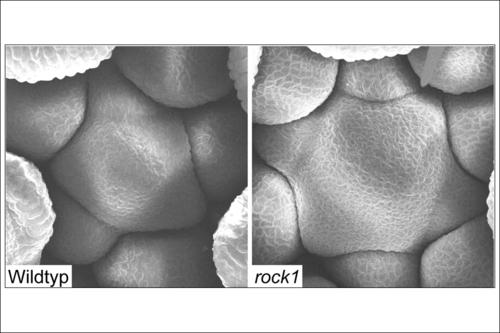A Sweet Kind of Control
Plant biologists from Freie Universität have discovered how a nucleotide sugar transporter affects the growth of plants.
Apr 14, 2015
This electron microscope image of the shoot apex shows that it is larger in Arabidopsis plants with a mutated ROCK1 gene. This means ROCK1 plants develop new flowers faster.
Image Credit: DCPS / Freie Universität Berlin
What does a specific nucleotide sugar transporter have to do with plant hormones? Plant researchers at the Dahlem Centre of Plant Sciences (DCPS) at Freie Universität asked themselves this question as part of their studies of the plant hormone cytokinin.
Although there appears to be no connection at first glance, closer research unlocks a further level of fine-tuning in the hormone balance. In the course of their studies, the biologists discovered that a transporter for specific forms of sugar that had previously only been known to exist in animal organisms also exists in plants.
Phytohormones control the growth and development of plants. This category also includes cytokinin, which plays an important role in cell division and cell differentiation in the roots and tips of shoots of plants. For these processes to move forward in an orderly fashion, there must be some way of controlling the hormone concentration in certain kinds of tissue.
The buildup and breakdown of this hormone is strictly regulated by various processes and at various levels. The genetic expression level is where it is determined which enzyme is produced to build the hormone and which is produced to break it down. Chemical reactions can change the enzymatically active proteins themselves and affect their activities. For example, introducing sugars often affects the stability of proteins, protects them against rapid decomposition, directs them to where they need to do their job, or affects their activity and links with other proteins. Sugar structures also support the correct folding and maturation of proteins that are awaiting discharge from the cell or integration into membranes.
Compensating for Hormone Deficiency
The studies conducted by the working group headed by junior professor Tomáš Werner started out by investigating dwarf-sized plants suffering from a lack of cytokinin. In these plants, an enzyme that breaks down cytokinin (cytokinin oxidase/dehydrogenase, or CKX) is present in excessive levels and is overly active. Isabel Bartrina and Michael Niemann, both biologists at the Dahlem Centre of Plant Sciences, used this genetic background to seek out mutated plants and normalize their growth.
On closer investigation of the mutations in these plants, they encountered a gene whose function they did not know. They named the gene “REPRESSOR OF CYTOKININ DEFICIENCY1” (ROCK1) based on its first noticeable function, suppressing cytokinin deficiency.
Together with scientists from research groups at the Hannover Medical School, Palacký University, in the Czech Republic, and the University of Natural Resources and Life Sciences, in Vienna, Bartrina and Niemann studied the function of the ROCK1 protein. After extensive genetic molecular and biochemical analyses, they concluded that ROCK1 transports activated forms of the sugars N-Acetylglucosamine (GlcNAc) and N-Acetylgalactosamine (GalNAc) into the endoplasmic reticulum within the cell. These findings were recently published in the prestigious journal Proceedings of the National Academy of Sciences of the United States of America (PNAS).
Controlling Protein Breakdown
While the function of these sugar residues in animal cells – for example, as sugar structures on proteins – is largely known, the functions and enzymes involved in plants are still mainly a new field for research. The analyses performed by Niemann and Bartrina indicate that the ROCK1 sugar transporter affects hormone concentration through the accumulation of sugar components on the hormone-metabolizing enzyme CKX by making a substantial contribution to regulating the breakdown of the enzyme.
If the sugar components are missing because the transporter (ROCK1) is defective, CKX probably cannot adopt its correct functional three-dimensional form. As a result, it is broken back down prematurely, so the cytokinin hormone is present in the plant for a longer time, regulating the plant’s growth. Plants with a ROCK1 mutation have more active shoot growth, which means they form more flowers and seed capsules accordingly.
The publication was recognized with the 2014 Krolow Award, which is granted in recognition of outstanding research findings by young scientists in the field of applied research on crop plants. The potential for boosting yield makes these findings from basic research interesting in applied terms as well.
Further Information
- Diana Mutz, Project Coordinator, Dahlem Center of Plant Sciences, Tel. +49 30 838-56214, Email: diana.mutz@fu-berlin.de

